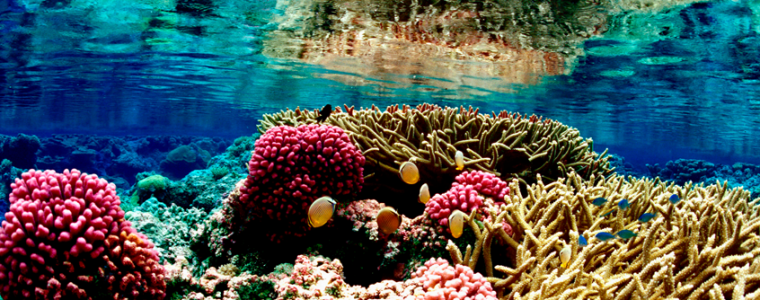The Great Barrier Reef off the coast of Australia has been making ocean news headlines recently. There’s good news and bad news, plus happenings down under that everyone concerned about one of the most amazing wonders of our world should be paying attention to.
One of the richest and most complex ecosystems on earth, the over 1800-kilometer Great Barrier Reef is actually an expanse of 2500 reefs and over 900 islands, including some that rise above sea level. The GBR’s incredible diversity of coral and sea life it supports, its importance to the global ocean environment and its spectacular marine scenery made it a no-brainer to be designated a World Heritage Site, an area considered to have “outstanding universal value” by UNESCO.
First, the good news: Researchers from James Cook University (JCU) in north Queensland have run unprecedented explorations of submerged reefs 10 and 30 meters below the ocean's surface on the Great Barrier Reef. While shallow reefs have been studied extensively, the GBR’s deep reefs are like hidden gems since they’re so hard to get to.
What the team found is quite startling and promising. Not only did they find corals they didn’t know were down there, turns out these deep corals were more environmentally stable than the shallow reefs. The deeper they went, the less the coral was impacted from threats such as ocean acidification causing bleaching and storm waves from cyclones. The scientists suspect this deep reservoir of corals could help rebuild the shallow coral systems. And it could mean the Great Barrier Reef may in reality be twice as big as currently estimated.
Now, the bad news: Researchers from the university discovered that corals in the reef are facing yet another direct hit. The Reef's corals are snacking on the micro-plastic pollution we’ve injected in the ocean. The corals are consuming indigestible microplastic, which is getting wrapped in their digestive tissue. This might interfere with the corals’ ability to digest its normal food, marine plankton. Researchers have known about this problem with whales and dolphins, fish, seabirds and other sea life, this is the first study to show that coral itself is swallowing our toxic trash.
Whatever the current state of the GBR, Australia’s federal government is investing heavily to ensure it isn’t declared “in danger” by UNESCO, which would put it on the list of World Heritage Sites which are considered in high risk due to environmental and other threats. The government appointed a task force to coordinate lobbying efforts with the UN world heritage committee nations’ delegates before the issue is considered this coming June. The task force reportedly organized a junket trip for journalists to tour the site in March, coinciding with Australia Prime Minister Tony Abbott releasing a 35-year plan to protect the reef and keep it off UNESCO’s danger list.
The plan does include some commendable initiatives. It would completely ban the dumping of dredging waste from shipping port expansions which has been damaging corals, and allocate AUS$100 million toward research, water quality programs and improving environmental practices from the fishing industry.
The plan also acknowledges that climate change is the biggest threat to coral reefs around the world. But this is where the story takes an ugly turn. Saying that climate change is a huge threat to the reef is one thing, planning to do something about it is a whole other ball of wax.
Environmentalists are critical of the plan, saying that despite Abbott’s admission, it barely addresses the threat of climate change to the Reef - even though the Australian government’s own scientists warn that climate change is its number one threat. Extreme weather and ocean acidification due to climate change are the biggest problems.
The plan doesn’t deal with the elephant under the rug, “King Coal” as it’s called in Australia. Ongoing coal port expansions to allow for bigger and more ships near the Reef are a concern, as are proposed coal mine expansions and new mines which would add hundreds of millions of tons of carbon dioxide into the planet’s atmosphere every year.
The Abbott’s administration attitude on addressing climate change appears to be a classic case of flip flop. The Prime Minister says he is taking climate change “very seriously,” yet has repealed measures that were in place to tackle it, such as Australia’s carbon pricing system, emissions reductions targets and government climate research.
Coal is a key sector of Australia’s economy. It produces and exports more than half the world's steel-making coal, worth A$40 billion a year. The Reef supports around 70,000 jobs to the tune of about A$5.6 billion a year. Between the two, there’s a lot at stake to keep the country’s reputation of environmental stewardship of the Reef intact.
Ultimately, the protection of the Great Barrier Reef and our planet’s ocean ecosystems must become a higher priority than new coal mines and more tourism dollars. As Australian poet and activist Judith Wright wrote in her book the “Coral Battleground” in 1977, the fate of the Reef is “a microcosm of the new battle within ourselves.”
We can continue to fuel our modern lifestyles at the expense of the ocean and planetary environment, or we can fight to counteract the human attitudes, industrial forces and public policies that have helped us get to this critical conservation crossroad with one of the most important natural features of our planet.
Let's choose wisely while there's still time.
Read more:
Australia’s New Plan To Save The Great Barrier Reef
The Great Barrier Reef: a battle with no end
Reports on Great Barrier Reef Conservation from Australian Government



